The Differences Between In-the-ear and Over-the-ear Hearing Aids
Hoglund Family Hearing & Audiology Center
For more information about the author, click to view their website: Hoglund Family Hearing
Aug 09, 2024
Florida - Southwest
Email US
Click to Email UsHearing aids are an essential and life-changing tool for anyone with hearing loss. However, with so many types of hearing aids available, it can be overwhelming to choose the right one. Hearing aids come in a variety of shapes, sizes, and styles, each designed to offer specific features to cater to different levels of hearing loss and individual preferences. The differences between in-the-ear and over-the-ear hearing aids are among the most significant considerations when choosing the best hearing aid for your needs.
Choosing the best hearing aid for you will depend on a number of factors, including your level of hearing loss, your lifestyle, aesthetic concerns, required features, and more. To ensure you receive the best treatment option for your needs, it’s best to consult a hearing healthcare specialist.
In this article, we will address the key differences between in-the-ear and over-the-ear hearing aids, including the various design styles, available features, care requirements, and more.
In-the-ear Hearing Aids for Mild to Severe Hearing Loss
In-the-ear (ITE) hearing aids are made to fit individual ears and are available in a variety of different styles, ranging from smaller and more discreet to slightly larger devices that offer more advanced functionality. They are custom fitted to your ear for maximum comfort and effectiveness. While not suitable for individuals with profound hearing loss, ITE hearing aids can treat a varying degree of hearing loss ranging from mild to moderate, and in some cases, severe.
The following is an overview of the most popular in-the-ear hearing aid styles listed from largest to smallest.
In-the-ear (ITE) Hearing Aids
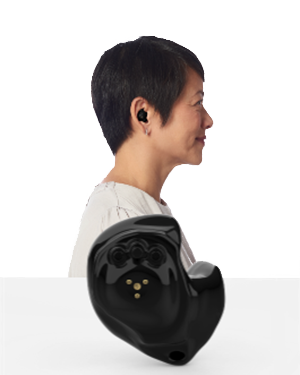
In-the-ear hearing aids are custom molded to fit comfortably inside the outer ear and can effectively treat mild to severe degrees of hearing loss. ITE hearing aids are the largest of all the styles of custom devices and can accommodate more advanced volume and microphone controls than some of the smaller styles.
In-the-canal (ITC) Hearing Aids
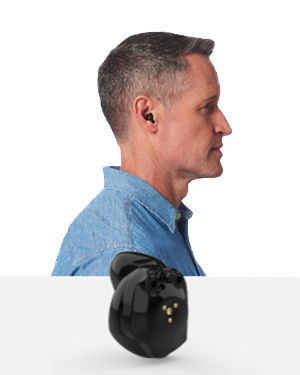
In-the-canal devices are the second largest style of hearing aid worn in the ear. They are custom molded to fit within the canal with a very small portion of the device visible in the outer ear. ITC hearing aids are suitable for people with mild to moderate degrees of hearing loss. While smaller than an ITE, many in-the-canal hearing aids can also accommodate more advanced volume and microphone controls.
Completely-in-the-canal (CIC) Hearing Aids

Completely-in-the-canal hearing aids are custom molded to fit completely inside the ear canal with only a tiny removal handle visible while being worn. CIC hearing aids are suitable for people with mild to moderate degrees of hearing loss. Due to their closed-fit design, CIC devices are much less likely to interfere with daily activities like using the phone, and they are also much less prone to wind interference, and feedback. However, the small design of CIC hearing aids does limit certain features like microphone controls and battery life expectancy.
Invisible-in-the-canal (IIC) Hearing Aids
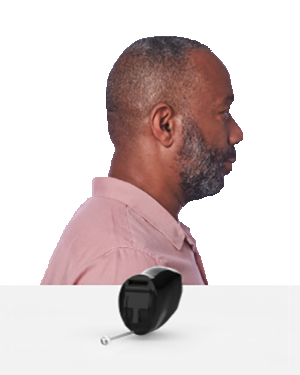
Invisible-in-the-canal hearing aids are the smallest and most discreet style of custom ITE devices and worn completely inside the ear canal, where no one can see them. IIC aids are a great option for patients with mild to moderate degrees of hearing loss. They are easy to wear and will not interfere with daily activities like using the phone, and wearers do not need to worry about wind interference, or feedback issues. However, due to their small size and deep fit within the ear canal, microphone controls are not available, and battery life expectancy is lower than with the ITE and ITC devices.
Over-the-ear Hearing Aids for Mild to Profound Hearing Loss
Over-the-Ear hearing aids are the most widely used devices due to their versatility. They are designed to accommodate more advanced degrees of hearing loss than custom ITE hearing aids, ranging from mild all the way to profound. Due to their larger size, they can house more advanced hearing technology, additional features, and have a longer battery life than most ITE aids.
The following is an overview of the standard hearing aid styles worn over the ear.
Behind-the-ear (BTE) Hearing Aids
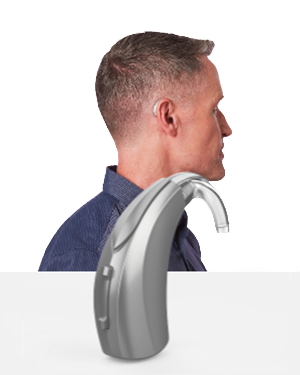
Behind-the-ear devices are the only type of hearing aid that can address every degree of hearing loss from mild to profound. They are designed with a durable plastic casing that rests behind the ear. The only thing that goes into the ear is either a tube or wire with a soft tip, or a custom-made ear mold, depending on the fitting, which is fitted into the outer ear canal.
Feedback and wind interference with BTE hearing aids are possible but should not be a common issue.
Receiver-in-canal (RIC) Hearing Aids
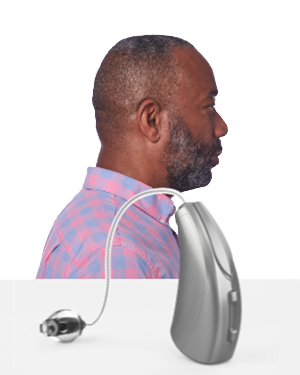
Receiver-in-the-canal hearing aids can treat mild to severe levels of hearing loss and are typically smaller than traditional behind-the-ear (BTE) models. RIC devices have an almost invisible wire connecting an exterior case to a tiny earbud that is comfortably inserted into the ear canal. This internal speaker design offers a more subtle look, which is often favored by hearing aid wearers.
RIC hearing aids are simple to insert and can support most hearing technologies. Like BTE devices, feedback and wind interference are possible, but should not be a common issue.
In-the-ear Hearing Aids vs Over-the-ear Hearing Aids
When it comes to comparing in-the-ear hearing aids and over-the-ear hearing aids, size and level of hearing loss are two of the most obvious differences. However, if your degree of hearing loss is less than severe, and you have the option of choosing between ITE and OTE devices, here are some of key factors to consider.
Comfort
The comfort of custom ITE hearing aids vs OTE hearing aids will vary from person to person. Devices worn In-the-ear are custom fitted to sit snugly in the ear canal, providing more comfort for some wearers. While over-the-ear hearing aids are larger, they are engineered to be very light, and comfortable to wear for long periods of time. However, standard over-the-ear styles may still be less comfortable for some users, especially those who wear glasses, hats, or facemasks regularly.
Aesthetics
When it comes to aesthetics, most people want their hearing aids to be as discreet as possible. With rapid advances in hearing technology, hearing aids of every type are getting smaller and smaller, while still providing excellent benefits and robust functionality. This means that both custom-made in-the-ear devices and standard over-the-ear devices are available in smaller, less noticeable styles and designs.
Maintenance
Cleaning and maintaining your hearing aids is very important to the life of the device. Wax and debris have the potential to interfere with the sound quality of the aid, so no matter the style of hearing aid you wear, it’s important that you clean them regularly. Because all hearing aids have a portion that fits inside the ear canal to deliver sound, they can be subject to wax build up and moisture from the ear. Wax and moisture can cause damage to hearing aids, so it’s very important to clean them daily, and have a conversation with your hearing healthcare professional about how and when to change your wax guards at home.
Batteries
The larger the hearing aid, the larger the battery it can accommodate, which is why in general, standard over-the-ear aids have longer battery life compared to some custom (CIC and IIC) devices. Today, standard hearing aids and even custom aids are both available in rechargeable battery options as well! You can expect standard hearing aid batteries to last anywhere from 3 days up to 10 days, but several factors can affect their lifespan, including the type and capacity of the battery, the amount and type of usage, as well as the specific type of hearing aid being used.
Find the Best Hearing Aid for You at Audibel
When it comes to taking control of your hearing health, one of the biggest and most rewarding decisions you can make is to address your hearing loss with hearing aids. ITE hearing aids are a great option for patients with mild to moderate or severe hearing loss looking for a custom-fit solution that is discreet as possible. OTE hearing aids are larger and more powerful, making them ideal for patients with any level of hearing loss including profound.
At Audibel, your hearing health is our primary concern, and we want to help you find the best hearing aid for your unique needs. We encourage you to take the first step to finding the personalized hearing healthcare you deserve by scheduling an appointment at any of our hearing clinics located throughout the United States.
- To view the original version of this article visit www.audibel.com/hearing-technology/in-the-ear-vs-over-the-ear-hearing-aids/
- Seniors Blue Book was not involved in the creation of this content.
Other Articles You May Like
How to Prevent Hearing Loss for Musicians
Because of the nature of their work, musicians of all genres are at risk for noise-induced hearing loss. Additionally, being able to hear properly is vital to the musicians livelihood, from being able to hear the right notes and words to playing in the correct pitch and key. Without proper hearing protection, the loud sounds most musicians experience on stage and while playing their instrument can cause permanent damage to their hearing. Additionally, musicians are also at risk for developing tinnitus, or a ringing-in-the-ears sensation. Tinnitus can be present with or without hearing loss, and while not life-threatening, can seriously deteriorate the quality of life for an individual.Hearing protection for musiciansBoth custom and non-custom products are available for musicians to help prevent hearing loss. Wearing the right ear protection not only helps combat hearing loss, but can also help to prevent tinnitus. Musician earplugs: These earplugs for made for musicians playing a variety of different types of instruments. Theyre available in several types of materials, from foam to a softer plastic, and enable the musician to still hear the music being performed. These earplugs are also beneficial for concert-goers to protect their hearing while still enjoying the music. Electronic earplugs: These earplugs are electronic and can be programmed to adjust to different pitches and sounds depending on the loudness and environment the musician is in. These adaptive earplugs allow musicians to hear the sounds that are important, while filtering out damaging noise levels. In-ear monitors: These high-tech devices are used by musicians or audio-engineer professionals and deliver sound to the ear while creating a barrier to background and damaging noise levels. In-ear monitors are available in custom or universal options. Who Can Benefit from Musician Earplugs?Musician earplugs and protection arent simply designed for individuals in a band, they can actually be beneficial to a number of different people, including: Students in the school band or orchestra Music teachers or conductors Concert or festival attendees Nightclub workers or patrons Entertainment industry staff Finding the right ear protectionFinding the right ear protection is vital for musicians to not only perform their jobs, but also prevent hearing loss. If you need additional information or assistance in purchasing musicians earplugs consider visiting a hearing professional near you. A hearing specialist will be able to evaluate your wants and ensure you find the right product for your specific needs.
Types of Hearing Loss
Hearing loss looks different on everyone. It can come on suddenly and cause permanent damage and it can gradually occur and make it difficult to identify. It even ranges from mild to profound and may vary across different pitches and frequencies. This is why Beltone Sound conducts a series of hearing tests before prescribing a solution. Our hearing aid specialists need to understand the unique nature of your hearing loss in order to match you with the best products possible.One of the most significant answers hearing tests can provide is whether your hearing loss can be categorized as conductive, sensorineural or mixed. This helps establish a foundation for the symptoms you are experiencing and helps determine the ideal solution. Conductive Hearing LossConductive hearing loss may be characterized by sounds that are muffled or far too quiet. It occurs when theres an issue with the way that sound is taken to the inner ear and a structure called the cochlea. This type of problem can be indicative of an issue with your ear canal, middle ear or eardrum.There are several potential causes of conductive hearing loss, including: Ear infections in the outer or middle ear Severe earwax blockage Deterioration of the middle ear bones Other problems with inner ear components If you have conductive hearing loss, it may be temporary or permanent. Conducting a full hearing test with a professional is the only way to make that determination.Sensorineural Hearing LossPeople with sensorineural hearing loss may struggle to discern speech from background noises and suffer from tinnitus. This type of hearing loss is caused by a problem with the sensory receptors in the hearing system. Its often the result of an abnormality or damage to the hair cells in the cochlea, which can prevent sounds from being transmitted to the brain properly. This type of hearing loss is typically permanent.Sensorineural hearing loss can be a congenital condition in that its existed since birth. But it can also be caused by age or damage to the hair cells in the cochlea through infection, drugs, trauma or over-exposure to noise.Mixed Hearing LossFinally, its also possible for you to be experiencing mixed hearing loss. This means that you have an issue with both your inner and outer ear components. Its a diagnosis of co-occurring sensorineural and conductive hearing loss.The best way to find out what type of hearing loss you have is to schedule an appointment. Our hearing aid specialists will evaluate your hearing system through tests and let you know what your best path forward is based on the results.
Understanding Tinnitus
Tinnitus is commonly described as a ringing, buzzing, whooshing or hissing sensation in your ears, but the sound isnt caused by an external noise. More than 50 million Americans experience tinnitus for a number of different reasons. To determine how to best treat tinnitus, its important to understand its symptoms and causes.Symptoms of tinnitusThere are a number of different symptoms for tinnitus, but the most common include hearing the following sounds: Ringing Buzzing Whooshing Hissing Clicking These sounds are heard only by the person experiencing the tinnitus, but can sometimes be detected by a hearing professional. These sounds can be heard constantly or intermittently. Some people have problems sleeping when they have tinnitus because they feel as though their brain never shuts off.Causes of tinnitusThere are several factors that can cause tinnitus, including the following: Exposure to loud noise Medication Hearing loss Ear infection Trauma to the ear Earwax buildup Menieres disease Vascular disorders Tinnitus may be caused by one or more of these conditions and some can be resolved easily if the cause is temporary, such as an infection or a buildup of earwax.Tinnitus treatmentsDepending on the cause of your tinnitus, there are a number of different treatment methods available to help you find relief. Your hearing care provider will assess the severity of your tinnitus, symptoms, how it impedes your daily life and possible causes and recommend one of the following solutions. Address the problem: If your tinnitus is due to earwax build up, medication or infection, theyll recommend the proper course to resolve the issue. This may include removing the earwax, switching medications or antibiotics. Behavioral therapy may also be recommended to help treat the varying emotions you may experience with tinnitus, from anxiety to anger. Hearing aids: Hearing devices are incredibly helpful in treating tinnitus. Even if a hearing loss isnt present, hearing aids can be equipped with tinnitus-masking features that help cover the tinnitus and offer relief from the unwanted noise. White noise machines: If your tinnitus isnt as severe or only experienced at nighttime, a white noise machine may be ideal for helping you find relief. White noise machines produce a steady sound to help mask the tinnitus noises you hear. Tinnitus retraining therapy (TRT): TRT is a form of therapy designed to help individuals with tinnitus find relief. This therapy involves retraining your mind to block out and hear certain tones, which in turn, helps to ease the symptoms caused by tinnitus. If you are suffering from tinnitus schedule an appointment with a hearing professional to be evaluated. The hearing provider will work to identify the cause behind your tinnitus and recommend the appropriate treatment.
Local Services By This Author
Hoglund Family Hearing & Audiology Center
Hearing-Audiologists / Hearing Aids 15 8th St., Ste. B, Bonita Springs, Florida, 34134At Hoglund Family Hearing and Audiology Centers, our goal is to provide the absolute best quality hearing services by removing communication barriers with clear, comfortable hearing. We understand that hearing is an important part of your health and significantly impacts your quality of life by allowing you to communicate and form relationships, promoting self-reliance and confidence. Being able to determine sounds and direction of sound contributes to your overall safety and sense of wellbeing. Hoglund Family Hearing and Audiology Centers offers hearing services for the hearing impaired. We strive to provide the best hearing aid solutions for your hearing loss.
